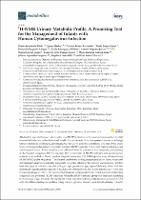1H-NMR Urinary Metabolic Profile, A Promising Tool for the Management of Infants with Human Cytomegalovirus-Infection
Author
Date
2019-11-25Permanent link
https://hdl.handle.net/11351/5850DOI
10.3390/metabo9120288
ISSN
2218-1989
WOS
000506676300007
PMID
31775291
Abstract
Congenital human cytomegalovirus (HCMV) infection is the most common mother-to-child transmitted infection in the developed world. Certain aspects of its management remain a challenge. Urinary metabolic profiling is a promising tool for use in pediatric conditions. The aim of this study was to investigate the urinary metabolic profile in HCMV-infected infants and controls during acute care hospitalization. Urine samples were collected from 53 patients at five hospitals participating in the Spanish congenital HCMV registry. Thirty-one cases of HCMV infection and 22 uninfected controls were included. Proton nuclear magnetic resonance (1H-NMR) spectra were obtained using NOESYPR1D pulse sequence. The dataset underwent orthogonal projection on latent structures discriminant analysis to identify candidate variables affecting the urinary metabolome: HCMV infection, type of infection, sex, chronological age, gestational age, type of delivery, twins, and diet. Statistically significant discriminative models were obtained only for HCMV infection (p = 0.03) and chronological age (p < 0.01). No significant differences in the metabolomic profile were found between congenital and postnatal HCMV infection. When the HCMV-infected group was analyzed according to chronological age, a statistically significant model was obtained only in the neonatal group (p = 0.01), with the differentiating metabolites being betaine, glycine, alanine, and dimethylamine. Despite the considerable variation in urinary metabolic profiles in a real-life setting, clinical application of metabolomics to the study of HCMV infection seems feasible.
Keywords
1H-NMR; Congenital infection; Human cytomegalovirusBibliographic citation
Frick MA, Barba I, Fenoy-Alejandre M, López-López P, Baquero-Artigao F, Rodríguez-Molino P, et al. 1H-NMR Urinary Metabolic Profile, A Promising Tool for the Management of Infants with Human Cytomegalovirus-Infection. Metabolites. 2019 Nov 25;9(12):288.
Audience
Professionals
This item appears in following collections
- HVH - Articles científics [4466]
- VHIR - Articles científics [1750]
The following license files are associated with this item:

 Private area
Private area Contact Us
Contact Us








